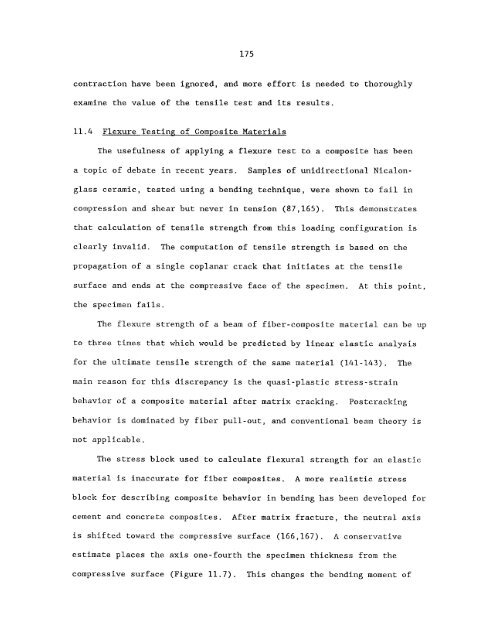Characterization and control of the fiber-matrix interface in ceramic ...
Characterization and control of the fiber-matrix interface in ceramic ...
Characterization and control of the fiber-matrix interface in ceramic ...
Create successful ePaper yourself
Turn your PDF publications into a flip-book with our unique Google optimized e-Paper software.
17 5<br />
contraction have been ignored, <strong>and</strong> more effort is needed to thoroughly<br />
exam<strong>in</strong>e <strong>the</strong> value <strong>of</strong> <strong>the</strong> tensile test <strong>and</strong> its results.<br />
11.4 Flexure Test<strong>in</strong>z <strong>of</strong> ComDosite Materials<br />
The usefulness <strong>of</strong> apply<strong>in</strong>g a flexure test to a composite has been<br />
a topic <strong>of</strong> debate <strong>in</strong> recent years. Samples <strong>of</strong> unidirectional Nicalonglass<br />
<strong>ceramic</strong>, tested us<strong>in</strong>g a bend<strong>in</strong>g technique, were shown to fail <strong>in</strong><br />
compression <strong>and</strong> shear but never <strong>in</strong> tension (87,165). This demonstrates<br />
that calculation <strong>of</strong> tensile strength from this load<strong>in</strong>g configuration is<br />
clearly <strong>in</strong>valid.<br />
The computation <strong>of</strong> tensile strength is based on <strong>the</strong><br />
propagation <strong>of</strong> a s<strong>in</strong>gle coplanar crack that <strong>in</strong>itiates at <strong>the</strong> tensile<br />
surface <strong>and</strong> ends at <strong>the</strong> compressive face <strong>of</strong> <strong>the</strong> specimen.<br />
At this po<strong>in</strong>t,<br />
<strong>the</strong> specimen fails.<br />
The flexure strength <strong>of</strong> a beam <strong>of</strong> <strong>fiber</strong>-composite material can be up<br />
to three tirncs that which would be predicted by l<strong>in</strong>ear elastic analysis<br />
for <strong>the</strong> ultimate tensile strength <strong>of</strong> <strong>the</strong> same material (141-143). The<br />
ma<strong>in</strong> reason for this discrepancy is <strong>the</strong> quasi-plastic stress-stra<strong>in</strong><br />
behavior <strong>of</strong> a composite material after <strong>matrix</strong> crack<strong>in</strong>g.<br />
Postcrack<strong>in</strong>g<br />
behavior is dom<strong>in</strong>ated by <strong>fiber</strong> pull-out, <strong>and</strong> conventional beam <strong>the</strong>ory is<br />
not applicable.<br />
The stress block used to calculate flexural strength for an elastic<br />
material is <strong>in</strong>accurate for <strong>fiber</strong> composites. A mare realistic stress<br />
block for describ<strong>in</strong>g composite behavior <strong>in</strong> bend<strong>in</strong>g has been developed for<br />
cement <strong>and</strong> concrete composites. After <strong>matrix</strong> fracture, <strong>the</strong> neutral axis<br />
is shifted toward <strong>the</strong> compressive surface (166,167). A conservative<br />
estimate places <strong>the</strong> axis one-fourth <strong>the</strong> specimen thickness from <strong>the</strong><br />
compressive surface (Figure 11.7). This changes <strong>the</strong> bend<strong>in</strong>g moment <strong>of</strong>

















